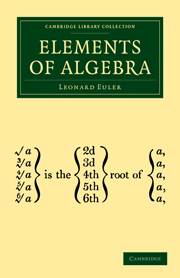Book contents
- Frontmatter
- ADVERTISEMENT
- MEMOIR OF THE LIFE AND CHARACTER OF EULER, BY THE LATE FRANCIS HORNER, ESQ., M. P.
- ADVERTISEMENT BY THE EDITORS OF THE ORIGINAL, IN GERMAN
- ADVERTISEMENT BY M. BERNOULLI, THE FRENCH TRANSLATOR
- Contents
- PART I Containing the Analysis of Determinate Quantities
- SECTION I Of the Different Methods of calculating Simple Quantities
- Chap. I OF Mathematics in general
- Chap. II Explanation of the signs + plus and − minus
- Chap. III Of the Multiplication of Simple Quantities
- Chap. IV Of the nature of whole Numbers, or Integers with respect to their Factors
- Chap. V Of the Division of Simple Quantities
- Chap. VI Of the properties of Integers, with respect to their Divisors
- Chap. VII Of Fractions in general
- Chap. VIII Of the Properties of Fractions
- Chap. IX Of the Addition and Subtraction of Fractions
- Chap. X Of the Multiplication and Division of Fractions
- Chap. XI Of Square Numbers
- Chap. XII Of Square Roots, and of Irrational Numbers resulting from them
- Chap. XIII Of Impossible, or Imaginary Quantities, which arise from the same source
- Chap. XIV Of Cubic Numbers
- Chap. XV Of Cube Roots, and of Irrational Numbers resulting from them
- Chap. XVI Of Powers in general
- Chap. XVII Of the Calculation of Powers
- Chap. XVIII Of Roots with relation to Powers in general
- Chap. XIX Of the Method of representing Irrational Numbers by Fractional Exponents
- Chap. XX Of the different Methods of Calculation, and of their Mutual Connexion
- Chap. XXI Of Logarithms in general
- Chap. XXII Of the Logarithmic Tables that are now in use
- Chap. XXIII Of the Method of expressing Logarithms
- SECTION II Of the different Methods of calculating Compound Quantities
- SECTION III Of Ratios and Proportions
- SECTION IV Of Algebraic Equations, and of the Resolution of those Equations
- PART II Containing the Analysis of Indeterminate Quantities
- ADDITIONS BY M. DE LA GRANGE
Chap. XX - Of the different Methods of Calculation, and of their Mutual Connexion
Published online by Cambridge University Press: 05 July 2011
- Frontmatter
- ADVERTISEMENT
- MEMOIR OF THE LIFE AND CHARACTER OF EULER, BY THE LATE FRANCIS HORNER, ESQ., M. P.
- ADVERTISEMENT BY THE EDITORS OF THE ORIGINAL, IN GERMAN
- ADVERTISEMENT BY M. BERNOULLI, THE FRENCH TRANSLATOR
- Contents
- PART I Containing the Analysis of Determinate Quantities
- SECTION I Of the Different Methods of calculating Simple Quantities
- Chap. I OF Mathematics in general
- Chap. II Explanation of the signs + plus and − minus
- Chap. III Of the Multiplication of Simple Quantities
- Chap. IV Of the nature of whole Numbers, or Integers with respect to their Factors
- Chap. V Of the Division of Simple Quantities
- Chap. VI Of the properties of Integers, with respect to their Divisors
- Chap. VII Of Fractions in general
- Chap. VIII Of the Properties of Fractions
- Chap. IX Of the Addition and Subtraction of Fractions
- Chap. X Of the Multiplication and Division of Fractions
- Chap. XI Of Square Numbers
- Chap. XII Of Square Roots, and of Irrational Numbers resulting from them
- Chap. XIII Of Impossible, or Imaginary Quantities, which arise from the same source
- Chap. XIV Of Cubic Numbers
- Chap. XV Of Cube Roots, and of Irrational Numbers resulting from them
- Chap. XVI Of Powers in general
- Chap. XVII Of the Calculation of Powers
- Chap. XVIII Of Roots with relation to Powers in general
- Chap. XIX Of the Method of representing Irrational Numbers by Fractional Exponents
- Chap. XX Of the different Methods of Calculation, and of their Mutual Connexion
- Chap. XXI Of Logarithms in general
- Chap. XXII Of the Logarithmic Tables that are now in use
- Chap. XXIII Of the Method of expressing Logarithms
- SECTION II Of the different Methods of calculating Compound Quantities
- SECTION III Of Ratios and Proportions
- SECTION IV Of Algebraic Equations, and of the Resolution of those Equations
- PART II Containing the Analysis of Indeterminate Quantities
- ADDITIONS BY M. DE LA GRANGE
Summary
206. Hitherto we have only explained the different methods of calculation: namely, addition, subtraction, multiplication, and division; the involution of powers, and the extraction of roots. It will not be improper, therefore, in this place, to trace back the origin of these different methods, and to explain the connexion which subsists among them; in order that we may satisfy ourselves whether it be possible or not for other operations of the same kind to exist. This inquiry will throw new light on the subjects which we have considered.
In prosecuting this design, we shall make use of a new character, which may be employed instead of the expression that has been so often repeated, is equal to; this sign is =, which is read is equal to: thus, when I write a = b, this means that a is equal to b: so, for example, 3 × 5 = 15.
207. The first mode of calculation that presents itself to the mind, is undoubtedly addition, by which we add two numbers together and find their sum: let therefore a and b be the two given numbers, and let their sum be expressed by the letter c, then we shall have a + b = c; so that when we know the two numbers a and b, addition teaches us to find the number c.
208. Preserving this comparison a + b = c, let us reverse the question by asking, how we are to find the number b, when we know the numbers a and c.
- Type
- Chapter
- Information
- Elements of Algebra , pp. 60 - 63Publisher: Cambridge University PressPrint publication year: 2009First published in: 1822

